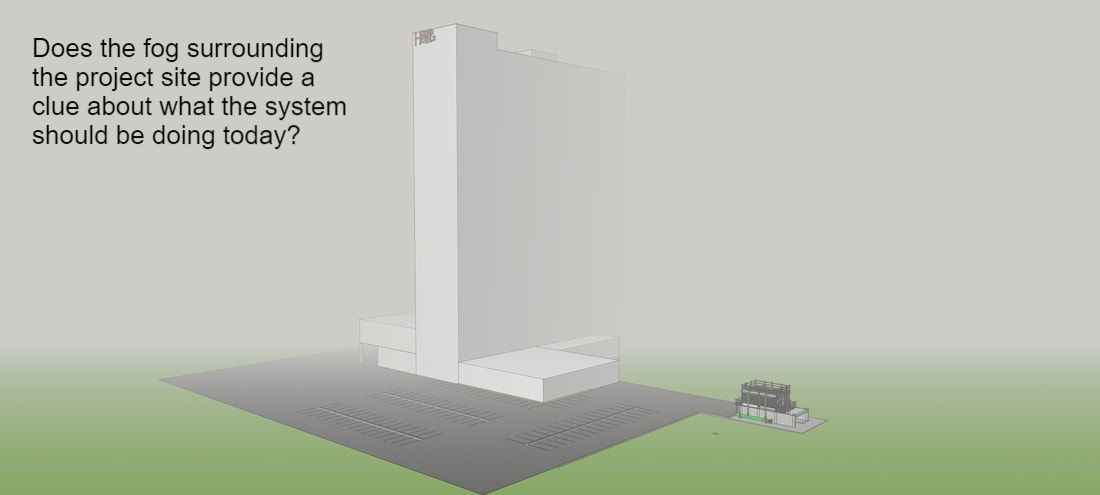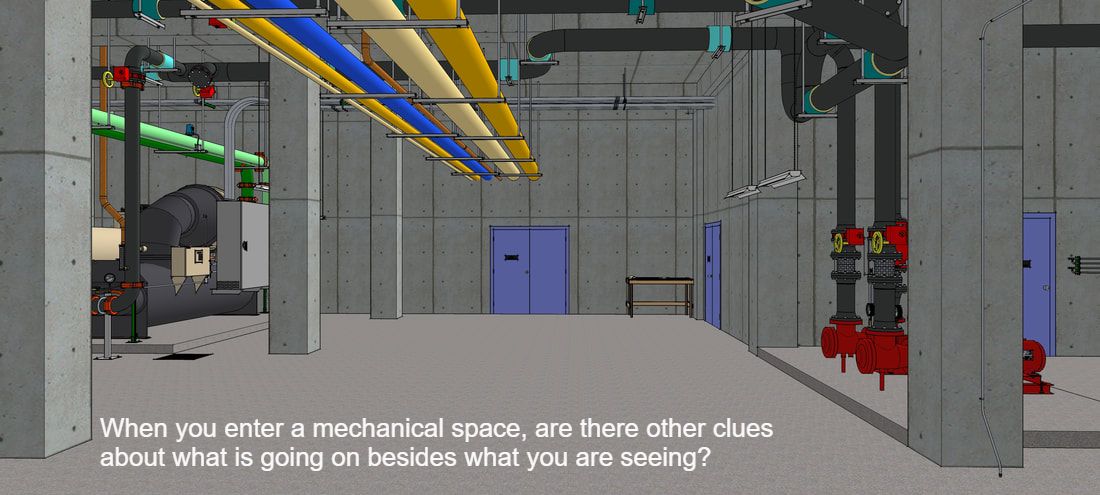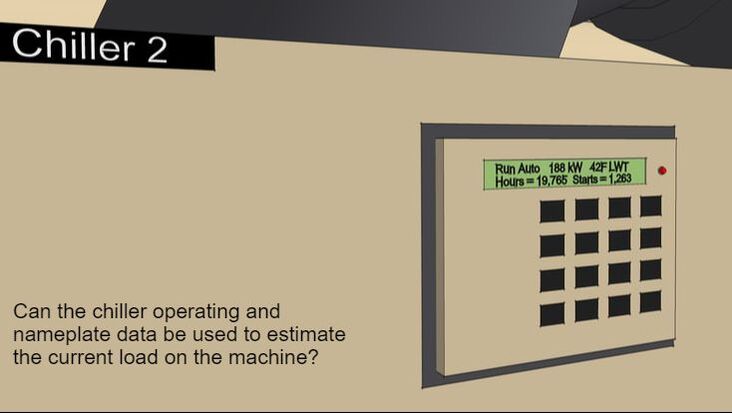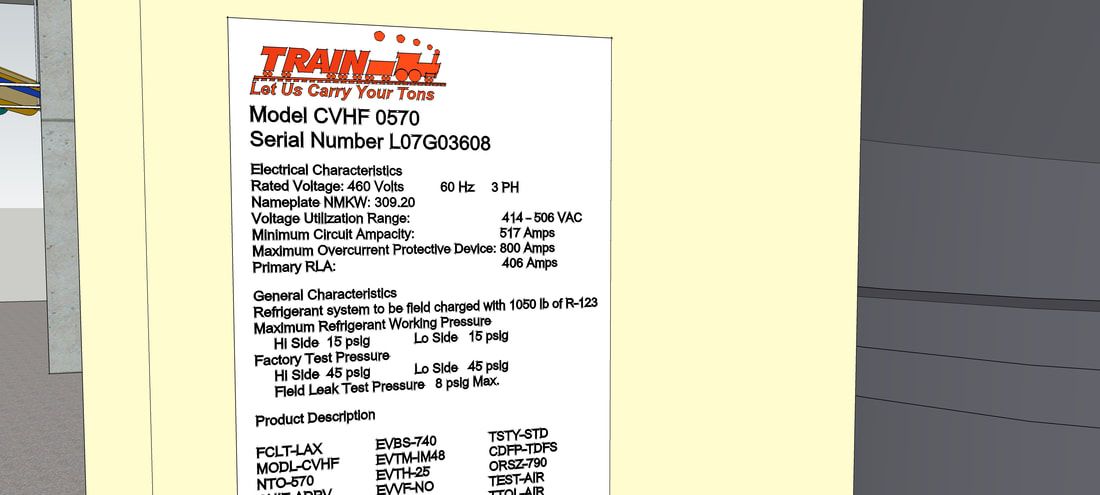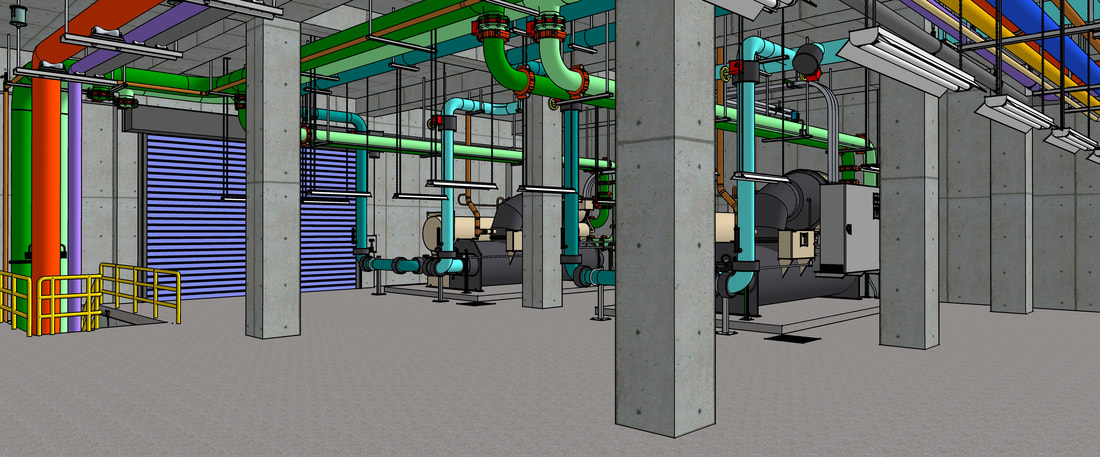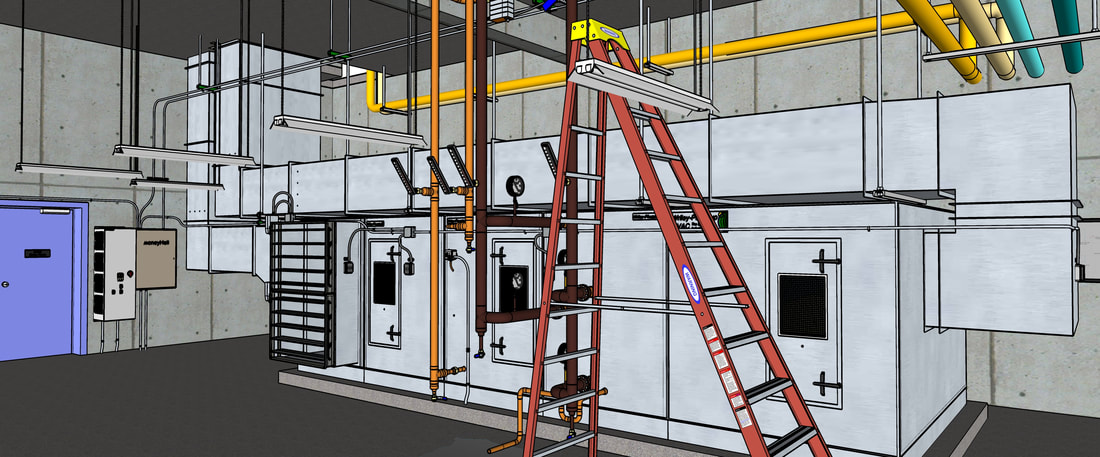The Hijend Hotel
The exercises under this page all take place at an imaginary hotel located in the San Diego, California area. You could do each exercise as a stand-alone exercise, but they are all inter-related in that the central plant is serving all of the loads and the day, and thus the operating scenario associated with each exercise is the same day. So in a perfect world, you would start with the chilled water plant exercise and then see where that takes you.
Jay Santo's (one of the founding principles at FDE) often says, existing building commissioning is about "following your nose". Meaning that if something "smells funny" then you follow your nose to find the source of the problem. For many folks in the EBCx business, myself included, working on existing buildings is like that. In other words, if you start with a central utility system and look at what is going on, it will often lead you to opportunities in the systems it serves. Similarly, issues you observe out at the loads will often lead you back to the central plant.
Jay Santo's (one of the founding principles at FDE) often says, existing building commissioning is about "following your nose". Meaning that if something "smells funny" then you follow your nose to find the source of the problem. For many folks in the EBCx business, myself included, working on existing buildings is like that. In other words, if you start with a central utility system and look at what is going on, it will often lead you to opportunities in the systems it serves. Similarly, issues you observe out at the loads will often lead you back to the central plant.
Setting the Scene
|
The Bay View Marquis Hotel and Marina is a full-service hotel owned and operated by two different divisions of Hijend Hospitality International, a major player in the hospitality industry. The company was started by Sven Hijend in the late 1920’s and is now run by his son Sven Jr. The Bayview facility was designed by the renowned architectural firm of Morgan, Wright, Jungermann and Kelly and is a favorite of both the Senior and Junior Hijend.
Known for its spectacular views of San Diego Bay, the facility served its first guests in early January of 2006 and has become a flagship for the company. Eighty percent occupancy is a slow day for them, and their average occupancy for the past two years has been 84%. |
For the Hijend Hotel exercise, you are going to imagine that you are a commissioning provider who has just secured a contract to support existing building commissioning at the facility under the auspices of the local utility incentive program. You have spent some time in your office looking at utility data for the facility along with the drawings and equipment specifications. As the exercise begins, you are heading out to the Hotel for your fist site visit to scope the facility by looking for what you call "obvious indicators of opportunity", things like throttled valves or selector switches that are in hand or operating modes that don't make sense in the context of the current conditions.
You will also be meeting with and interviewing some of the operating team at the hotel. In addition, when you called to set up the site visit, the chief said she was also hoping to have the utility incentive program manager come along to do their audit of the facility at the same time. She really likes the passion the young PM has for the project. But she is a little worried about his level of familiarity with HVAC systems because when she and her general manager were giving him a quick tour when they signed up for the program, the PM said he was hoping that they could show him their chillers.
At the time, they were standing in the central plant next to one that was running at about 80% load. So, she is hoping that if the PM can come along on the walk through with you today, they can benefit from some of your experience and that their audit will capture all of the opportunities as a result.
You will also be meeting with and interviewing some of the operating team at the hotel. In addition, when you called to set up the site visit, the chief said she was also hoping to have the utility incentive program manager come along to do their audit of the facility at the same time. She really likes the passion the young PM has for the project. But she is a little worried about his level of familiarity with HVAC systems because when she and her general manager were giving him a quick tour when they signed up for the program, the PM said he was hoping that they could show him their chillers.
At the time, they were standing in the central plant next to one that was running at about 80% load. So, she is hoping that if the PM can come along on the walk through with you today, they can benefit from some of your experience and that their audit will capture all of the opportunities as a result.
|
As you drive towards the site, the weather forecast you are listening to is predicting a cool, foggy morning with temperatures running in the low to mid 50°F until mid-afternoon when then sun is expected to burn through and warm things up. As you drive in towards town, the hotel begins to emerge from the fog and you see the cooling towers across from the central plant.
|
If you are correctly remembering the walk-through you had during your interview, there are a number of air handling systems adjacent to the central plant, primarily serving the back of the house, the lobby, and the restaurant areas. The ball-room and meeting room systems are at the far end of the first floor and the large make-up systems serving the guest room corridors are located in equipment rooms on the roof
As suggested by the chief engineer, you park in the employee area near the cooling towers and make your way to the front desk to have them page the chief. After thanking you for choosing Hijend Hotels, the associate calls down to engineering to see where the chief is. After a brief conversation, he hangs up and says that he will have security escort you down to the central plant where the chief will meet you as soon as she can.
As suggested by the chief engineer, you park in the employee area near the cooling towers and make your way to the front desk to have them page the chief. After thanking you for choosing Hijend Hotels, the associate calls down to engineering to see where the chief is. After a brief conversation, he hangs up and says that he will have security escort you down to the central plant where the chief will meet you as soon as she can.
|
When you arrive at the central plant, you are greeted by the sound of a chiller and pumps in operation. That surprises you a bit given the fog and how cool it is outside. More specifically, you find yourself wondering if there is some sort of load on the system that does not have the benefit of using outdoor air for cooling. Looking around, you notice a plan table in the corner. Maybe there are some clues in the drawing set lying there.
As you head towards the plan table, you start to sketch out a system diagram of the chilled water side of the plant to help you understand how it works, noting things like the rated flow rates for the pumps and other equipment. By the time the chief and her lead engineering technician arrive, you are over at the chiller noting the current operating state and estimating the load on the system. After exchanging a few pleasantries, you suggest that the three of you start by taking a look around the chiller plant. Given the weather, you are a bit surprised to find the plant running at all since your furnace at home was running when you left and your recollection is that all of the air handling systems are all either make-up air systems or have economizers. So you would like to get a sense of the load on the chillers. It could be that they just happen to be running at minimum load and are cycling frequently. But you are starting to doubt that since you have been in the plant for 15-20 minutes at this point and they have not cycled. |
Everyone agrees that the central plant is a good place to start so you continue your exploration. As you do that, the lead technician explains that given all of the military bases in the area, a lot of their regular guests are high ranking military or ex-military officers. Given the rates they are paying, the hotel wants to be sure they have cooling at any time they want it to avoid complaints from people accustomed to chewing out junior officers.
The operating team jokingly calls them the Ex-warriors bold who like their room cold, and in their efforts to “keep the peace”, they keep the plant running round-the-clock. And its probably a good thing he says, because they always seem to have at least 150 tons of load or more. That probably translates to lots of happy customers.
You agree that guest satisfaction is the hotel's main mission. But considering the perimeter location of the guest rooms and the amount of glass and the patio doors that they have, you are thinking the guest room loads would be loads that were more like your house. Sure, if they were facing south on a cool but sunny day, they might need some cooling if the guest did not want to open the patio door. And certainly if the room was idle and had drifted up into the low to mid 70°F range and one of the ex-warrior's came in an cranked down the thermostat, there would be a pull-down load for a while.
But on this cool foggy morning, the furnace in your house was running when you left. So, if your theory about a guest room load being more like your house than not is correct, then it is hard to imagine the guest rooms represent much of a load currently. If you combine that with the nature of the other loads in the facility with their access to outdoor air for cooling, it sure seems like there should not be much need for chilled water on a day like the day of your visit.
The chief breaks stride for a minute, looks up at you and says, You know, I never thought about it like that. Now you’ve got me curious.
Thus begins your work at the San Diego Bay View Marquis Hotel and Marina. To move forward, all you need to do is pick one of the exercises below and follow the link to that page. Each exercise can stand on its own. But my recommendation would be that you start with the chilled water system exercise, which picks up where the narrative above left off. When you go to that page, you will find that I have included some leading questions to help you get started.
Next, take a look at the Ballroom AHU. Given that it is one of the loads served by the chilled water plant, there could be things going on with it that might explain any dysfunction you might have observed in the central plant. This exercise also has some leading questions to help you get going.
Finally, head out to the cooling tower and condenser pump room associated with the central plant. Since the central plant is the load on the cooling towers, dysfunctions in one system will often manifest themselves in the other system. This exercise does not have any leading questions and there is a reason for that. The idea is for you to use the first two exercises to develop your skills with a bit of help from the leading questions. This one turns you loose on your own so you can practice what you have learned drawing on your own experience and develop some confidence that way.
The operating team jokingly calls them the Ex-warriors bold who like their room cold, and in their efforts to “keep the peace”, they keep the plant running round-the-clock. And its probably a good thing he says, because they always seem to have at least 150 tons of load or more. That probably translates to lots of happy customers.
You agree that guest satisfaction is the hotel's main mission. But considering the perimeter location of the guest rooms and the amount of glass and the patio doors that they have, you are thinking the guest room loads would be loads that were more like your house. Sure, if they were facing south on a cool but sunny day, they might need some cooling if the guest did not want to open the patio door. And certainly if the room was idle and had drifted up into the low to mid 70°F range and one of the ex-warrior's came in an cranked down the thermostat, there would be a pull-down load for a while.
But on this cool foggy morning, the furnace in your house was running when you left. So, if your theory about a guest room load being more like your house than not is correct, then it is hard to imagine the guest rooms represent much of a load currently. If you combine that with the nature of the other loads in the facility with their access to outdoor air for cooling, it sure seems like there should not be much need for chilled water on a day like the day of your visit.
The chief breaks stride for a minute, looks up at you and says, You know, I never thought about it like that. Now you’ve got me curious.
Thus begins your work at the San Diego Bay View Marquis Hotel and Marina. To move forward, all you need to do is pick one of the exercises below and follow the link to that page. Each exercise can stand on its own. But my recommendation would be that you start with the chilled water system exercise, which picks up where the narrative above left off. When you go to that page, you will find that I have included some leading questions to help you get started.
Next, take a look at the Ballroom AHU. Given that it is one of the loads served by the chilled water plant, there could be things going on with it that might explain any dysfunction you might have observed in the central plant. This exercise also has some leading questions to help you get going.
Finally, head out to the cooling tower and condenser pump room associated with the central plant. Since the central plant is the load on the cooling towers, dysfunctions in one system will often manifest themselves in the other system. This exercise does not have any leading questions and there is a reason for that. The idea is for you to use the first two exercises to develop your skills with a bit of help from the leading questions. This one turns you loose on your own so you can practice what you have learned drawing on your own experience and develop some confidence that way.
CHW System Scoping ExerciseThis exercise will allow you to practice your scoping skills by exploring the central chilled water plant, looking for obvious indicators of energy and resource savings opportunities. The "answer" in the form of a findings list is provided, which includes next steps for moving forward with assessment and implementation for each finding.
|
|

